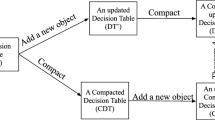Abstract
In the process of data analysis in Pawlak’s information system and in the derivation of decision algorithms from decision tables, the main computational effort is associated with the determination of the reducts. The notion of the reduct plays a major role in the definitions of other fundamental notions of the information systems theory, such as functional dependencies, redundancy etc. The purpose of the presentation is to show that role and demonstrate different ways of computing reducts. The computational complexity of the problem of reducts enumeration is, in the worst case, exponential with respect to the number of attributes. Therefore the only way to achieve its faster execution is by providing an algorithm, with a better constant factor. The algorithm presented computes reducts from the sample set of objects. The corresponding data available for the analysis in real-life applications is subject to some dynamic changes. Thus it would be useful to have a facility to support such a behaviour. The presented algorithm is based on the strategy of the maintenance of the set of reducts — providing their necessary alternations triggered by an expansion of the set of objects. The algorithm is demonstrated in a nontrivial example. The significance of the offered solution is twofold; the avoidance of the repetition of the whole (standard) procedure for the dynamically changing data, and an improvement of the execution time in comparison to the standard methods.
Access this chapter
Tax calculation will be finalised at checkout
Purchases are for personal use only
Preview
Unable to display preview. Download preview PDF.
Similar content being viewed by others
References
Buszkowski W, Orlowska E (1986), On the Logic of Database Dependencies, Bull. Polish Acad. SCi. Math., 34, pp 345–354.
Cendrowska J (1987), PPRISM: An Algorithm for Inducing Modular Rules, Int. Journal of Man-Machine Studies, 27, pp 349–370.
Codd E F (1970), A Relational Model of Data for Large Shared Data Banks, Communications of ACM, 13, pp 377–387.
Maier D (1983), The Theory of Relational Databases, Computer Science Press, Rockville.
Orlowska E (1983), Dependencies of Attributes in Pawlak’s Information Systems, Fundamenta Informaticae, 6, pp 247–256.
Orlowski M (1992), Maintenance of Decision Algorithms, School of Information Systems Report, 2/92, QUT Brisbane
Pawlak Z (1981), Information Systems — Theoretical Foundations, Information Systems, 6, pp 205–218.
Pawlak Z (1985), On Rough Dependency of Attributes in Information Systems, Bull. Polish Acad. SCi. Math., 33, pp 551–559.
Pawlak Z (1990), Rough Sets; Theoretical Aspects of Reasoning about Data, (manuscript; monograph in submission)
Pawlak Z, Slowinski K, Slowinski R (1986), Rough Classification of Patients after Highly Selective Vagotomy for Duodenal Ulcer Int. Journal of Man-Machine Studies, 24, pp 413–433.
Rauszer C M (1985), Dependency of Attributes in Information Systems, Bull. Polish Acad. SCi. Math., 33, pp 551–559.
Rauszer C M (1985), An Equivalence between Theory of Functional Dependencies and Fragment of Intuitionistic Logic, Bull. Polish Acad. SCi. Math., 33, pp 571–579.
Rauszer C M (1988), Algebraic Properties of Functional Dependencies, Bull. Polish Acad. SCi. Math., 38, pp 561–569.
Author information
Authors and Affiliations
Editor information
Editors and Affiliations
Rights and permissions
Copyright information
© 1992 Springer Science+Business Media Dordrecht
About this chapter
Cite this chapter
Orlowska, M.E., Orlowski, M.W. (1992). Maintenance of Knowledge in Dynamic Information Systems. In: Słowiński, R. (eds) Intelligent Decision Support. Theory and Decision Library, vol 11. Springer, Dordrecht. https://doi.org/10.1007/978-94-015-7975-9_20
Download citation
DOI: https://doi.org/10.1007/978-94-015-7975-9_20
Publisher Name: Springer, Dordrecht
Print ISBN: 978-90-481-4194-4
Online ISBN: 978-94-015-7975-9
eBook Packages: Springer Book Archive




